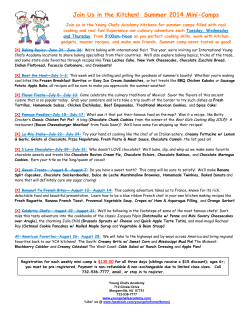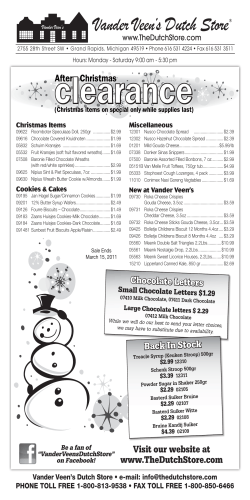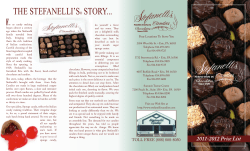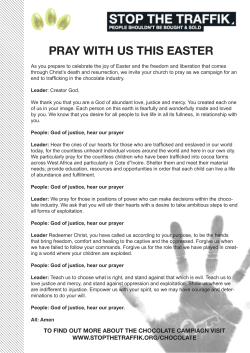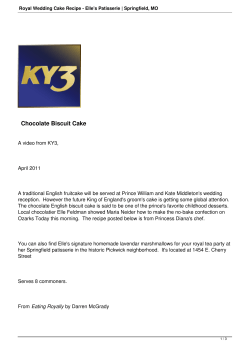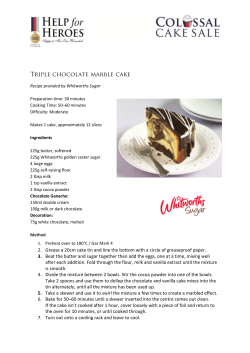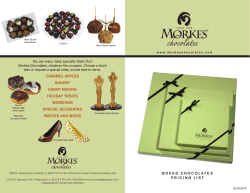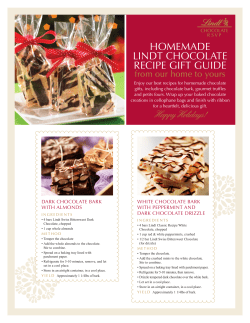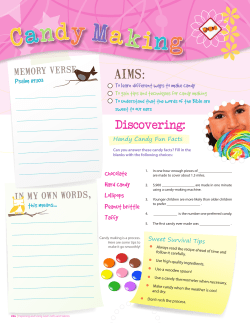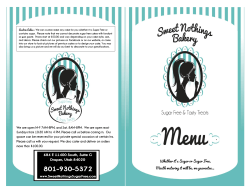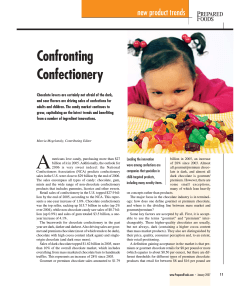
Candy Making Tips
Candy Making Tips MELTING CHOCOLATE WITH LIQUID If your recipe calls for melting chocolate along with water or some other type of liquid, be sure that the liquid is mixed with the chocolate from the beginning of the melting process, then it won´t get grainy on you. Be careful though, because adding even a drop in mid-melting will cause seizing. OVEN MELTED CHOCOLATE Alternatively, you can melt chocolate in a dry oven. Place grated chocolate in a metal bowl and place it in an oven set at 110° F. (If your oven doesn´t go that low, use the lowest temperature and keep the door ajar.) Your chocolate will melt in about an hour. When melting chocolate be careful not to overcook or burn. If you are careful, you can melt it either in the microwave in 10-second increments or in a double boiler. (If you don't have a double boiler, use two saucepans, one larger than the other, with enough boiling water in the larger one to just reach the bottom of the smaller one, where the chocolate is, and keep stirring.) DIPPING CHOCOLATE To create a chocolate coating of manageable consistency for candies and other treats, add shortening or peanut or vegetable oil in a ratio of 1 tablespoon fat to 6 - 8 ounces of solid chocolate and melt them together. Why Chocolate Turns Gray or Discolored Sometimes There is nothing quite like opening a much-anticipated box of chocolates only to find discolored, slightly gray candy. When chocolate turns gray like that, one of two things could be the culprit: Sugar Bloom or Fat Bloom. Sugar Bloom Sugar bloom is normally caused by surface moisture. The moisture causes the sugar in the chocolate to dissolve. Once the moisture evaporates, sugar crystals remain on the surface. If this process is repeated, the surface can become sticky and even more discolored. Although sugar bloom is most often the result of overly humid storage, it can happen when the chocolate has been stored at a relatively cool temperature and is then moved too quickly into much warmer surroundings. When this happens, the chocolate sweats, producing surface moisture. Fat Bloom Fat bloom is similar to sugar bloom, except that it is fat or cocoa butter that is separating from the chocolate and depositing itself on the outside of the candy. As with sugar bloom, the most common causes of fat bloom are quick temperature changes and overly warm storage. Although it might look a little less appetizing than a lustrous, rich chocolaty-brown piece of candy, chocolate that has suffered bloom is still okay to eat. You may find the texture of sugar-bloomed chocolate to be a bit grainy on the outside, but it should still taste good. To prevent this from happening to your chocolate, simply use proper storage methods. How to Store Chocolate Whether it is white chocolate, baking chocolate, milk chocolate or some kind of chocolate confection, proper storage is important. Since it can easily absorb flavors from food or other products located nearby, chocolate should be tightly wrapped and stored away from pungent odors. The ideal temperature for storage is somewhere between 65º - 68º F (18º - 20º C), with no more than 50 to 55 percent relative humidity. If stored properly, you can expect milk chocolate and white chocolate to be good for up to six months. Other types of chocolate can have an even longer shelf life. Cooked Candies There are three important things to remember when preparing cooked candies: FIRST, it is necessary to prevent large sugar crystals from forming since they cause the candy to become grainy and coarse in texture. To prevent large crystals the sugar should be completely dissolved. Large crystals can form on the side of the saucepan; they should be washed down before a candy thermometer is placed in the pan. To wash down the crystals from the side of a pan, use a pastry brush dipped in hot water. Gently brush the crystals down into the syrup or collect them on the brush bristles. Dip the brush frequently in hot water to clean off the bristles. Another easy way to wash down crystals is to place a cover on the pan for 2 or 3 minutes. This allows the trapped steam to wash down the crystals. If you use the cover method, make sure the syrup does not boil over. SECOND, it is important to cook candy to the correct temperature. If you make cooked candy often, a candy thermometer is essential. Most candy recipes are designed and tested for sea level, so at higher altitudes temperature adjustments are necessary--you can decrease the cooking temperature in the recipe by 2º for each 1,000 feet of elevation. The candies concentrate much faster at higher altitudes; therefore, lower temperatures and shorter cooking times are required. For Weber County residents (other than up in the valley) you would subtract 8º or 9º degrees off the recipe. The shape, size and thickness of the pan will determine the time required for the syrup to reach its final temperature. Times given in recipes are only approximate. It is more important to refer to the temperatures of the syrups. Also, the temperatures are given in ranges. To achieve the proper consistency, the syrup must be heated to at least the minimum temperature without exceeding the higher temperature. Heating the syrup concentrates it. The longer the syrup is heated, the more liquid is evaporated and the more concentrated the syrup becomes. The higher the temperature, the firmer and more brittle the candy will be. THIRD, candies, such as fudges, must be cooled to lukewarm before they can be beaten and shaped. This cooling can take up to 2 hours for large fudge recipes and patience is necessary. Do not place the hot candy mixture in the refrigerator, freezer or sink of cold water to cool—unless noted in the recipe. Saucepans Heavy saucepans with flat bottoms will prevent candy from scorching during cooking. Pans should be large enough to prevent syrups from boiling and foaming over the rims. Always use the size pan suggested in the recipe and it is suggested to never double cooked-candy recipes. It throws the timing and heating off. Soft-ball stage: In candy making the point at which heating sugar syrups either reach 234º F. on a candy thermometer OR when a little bit of the syrup dropped in cold water makes a soft little candy ball. When cooking any candy do not let your candy thermometer touch the bottom of the pan or you will get inaccurate readings and eventually the device will explode, which would be very dangerous. Also, be very careful of the candy syrup—it is extremely hot and will burn skin very badly and deeply. Wooden spoons are preferable to anything else because they don't conduct heat and don't add an off-taste to the candy. • • • • Keep nuts in the fridge or freezer to maintain their freshness. Due to allergies so many people have, make sure that you inform all recipients which confections have nuts and what kind(s). You can substitute margarine for butter in these recipes, but, the fact is, most people agree that butter is better and the small difference in expense makes a huge difference in taste. Finally, for an extra blast of flavor, add vanilla to any recipe that calls for chocolate. Once chocolate has been melted, it gets a rough sort of grainy taste, but even a little bit (1/4 teaspoon) of vanilla smooths it out. Buy good vanilla (not vanillin) and in quantities you will be using soon since it loses its strength over time.
© Copyright 2025
